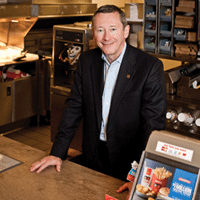— COMPANY OF THE YEAR —
The recession took its toll on restaurants, forcing cutbacks, closings and all-around consternation. At McDonald’s, it met its match
In an Aug. 11 story on Slate.com, writer Daniel Gross posed the question, “Who Won the Recession?” His answer — thanks to 2008 global sales growth that outpaced both previous years, a slew of new openings around the world and same-store sales increases for each of the first seven months of 2009 — was McDonald’s.
Casual Internet surfers can be forgiven if they scrolled past the headline, assuming the nod came as a result of the ‘trading-down’ phenomenon — an immediate, widespread reaction by consumers during any economic downturn — which in turn led to a tidy increase in traffic and sales.
While the trend certainly had a positive impact on performance, John Betts, president and CEO of McDonald’s Restaurants of Canada Limited, stresses that his company’s successful run is the result of much more than that.
“When you think about the recent global economic chaos, the quick thought for a lot of businesses is to shoot for one particular solution — price and value,” says Betts, cloistered in a booth one rainy morning at a newly renovated McDonald’s in Toronto. “That’s been our trademark for years. But consumers are looking for more than price. They’re looking for the overall experience.”
Thanks to shrewd corporate planning, the number of Canadians ‘experiencing’ McDonald’s in 2009 is significantly higher than usual. By the third quarter it had attracted about 23 million more customers than it did last year, which is in the range of seven or eight per cent growth. “In Canada, we’ve had an unbelievable year,” confirms Betts, who took the helm of McDonald’s Canada in February 2008.
The son of an American diplomat, Betts spent much of his youth living in various exotic ports in Europe. Tall and thin, he looks and speaks like the CEO of a major corporation, but there’s a sense of an everyday-kind-of-guy lurking underneath, likely cultivated through three decades of working under the Arches. “We’re also on track to break $3 billion in sales for the first time in Canada,” he says proudly. If you take into account the recent results for the third quarter — McDonald’s Corp.’s global profits climbed almost six per cent — just like its stock prices, things are looking up.
The numbers are more impressive when you factor in recent data that shows the quick-service segment didn’t see all that much recession-driven growth in Canada. According to Robert Carter of the Toronto-based NPD Group, while family mid-scale chains attracted eight per cent more diners and garnered 10 per cent dollar growth in May ’09 compared to May ’08, QSR chains drew just two per cent more customers and five per cent more sales over the same period. It’s a trend McDonald’s Corp. CEO Jim Skinner believes is a global phenomenon, driven by what he recently called a “declining informal eating-out market around the world.” But while the fast-food business is experiencing slowed growth, Skinner expects McDonald’s business to continue to grow, thanks in part to a refocused effort on its core values — building business through quality service and value; the same ethos Ray Kroc shared when he launched the chain 55 years ago — and on new philosophies as well.
The growing attraction consumers have for the brand today is driven by value, new menu items (alongside old favourites), savvy marketing and renovated stores that are open longer — each prime tenets of the corporation’s “Plan to Win,” which was launched in 2002. “We saw results fairly quickly,” says Betts of the two-pronged global strategy. “In the beginning there was a going back to our roots, focusing on value, great food, well-run restaurants and a good experience. As the plan grew over the years, we started to re-image our restaurants, to upgrade the experience from a dining standpoint and keep the stores open longer.”
These changes came after the company had reached what Betts told the National Post in September was a “low ebb” in 2003, when McDonald’s Corp. saw its first quarterly loss as a public company. Some of that performance hiccup can likely be attributed to the public flogging it received in the book Fast Food Nation and, later, the film Super Size Me. But McDonald’s took a proactive approach to the criticisms of being an industrialized corporate entity serving unhealthy food. It recognized that the modern foodservice industry is dynamic and changing, and so are consumers, and if you don’t stay ahead of that evolution you’ll soon fall behind. The Plan to Win aimed to right the ship.
Once every owner/operator, supplier and employee was aligned around the strategy, the momentum started building, says Betts. With consumers’ needs evolving throughout the decade, McDonald’s expanded the scope and variety of its menu and added healthier items. Alongside refreshed stores and longer hours, it helped to reconnect the brand with many customers. “We now serve grilled products, fruit and yogurt parfaits, premium burgers, snack wraps and salads, although people still love our great-tasting Big Macs and fries,” he says, adding they’re selling more of those than ever.
“[The Plan to Win] has started to show in our venues and in our relevance to the consumer,” says Dave Murray, owner/operator of four McDonald’s stores in Quebec and Atlantic Canada, over the phone one afternoon. “We’re keeping our stores open later, and in many cases they’re open 24 hours. Some of our restaurants were getting old and tired looking, so we made a huge effort to give them a look that’s relevant to today’s consumer.” Many of the renovations cost upwards of half a million dollars.
But Murray, also a 30-year veteran of the company, points to an internal shift for its quick ascent back. “I’ve seen a huge change in the past six years between owner/operators and the way they perceive their partnership with our corporate partners. It’s to the point now where we’re able to sit in a room and drive strategic direction, and we get there quickly.”
To wit: McDonald’s massive free coffee promotion this past April. “That was a huge initiative and a big investment, one which we would not have had buy-in from the owner/operator community previously,” he says. “Sure, we had some healthy discussion, but at the end of the day there was a pretty unanimous approach to it.”
Murray credits Betts’ leadership for many of the positive changes at McDonald’s. And, regarding the much ballyhooed two-week free coffee promotion — which actually didn’t include new coffee at all, but rather took the same premium roast drip blend it came up with four years ago and refined how it was brewed and merchandised — he says the timing couldn’t have been better. “In the fall of last year there were dark clouds on the horizon. But we knew we had to do something to really impress the consumer when it came to value. And there’s nothing like free.”
According to Murray, some stores saw a 500-per-cent increase in the amount of coffee brewed during the event, adding that he’s now up 30 per cent in breakfast sales in his markets. The giveaway was a great way to re-introduce customers to the chain’s breakfast program, but it also gave McDonald’s a platform to unveil the new look and feel of many of the restaurants. Stroll into any re-imaged store and gone are the ketchup and mustard-coloured formica tables and chairs, and gigantic Grimace and Hamburgler cutouts. New restaurants feature warm, neutral tones, expensive-looking tile, creatively shaped booths, sleek menu boards and an all-around coffeehouse feel. Some have fireplaces in the middle of the dining area, like pseudo, new-age hearths. It’s a much more mature environment that reflects the evolution of the Arches themselves.
“We’ve re-imaged a little over 300 stores so far [using mainly local contractors] and we’ll have our entire system done over the next several years,” says Betts, stressing that McDonald’s is currently not pushing to expand its footprint in Canada. “We’re clearly doing more business by making our existing facilities more contemporary and by focusing on having a better menu. I suspect we’re going to stay on this tack for the next few years.”
On the heels of the positive buzz around the coffee promotion and renovated stores, McDonald’s launched a successful summer promotion featuring four new, upscale salads. “We partnered with fashion designers in Toronto,” says Louis Payette, national media relations manager, of the innovative product launch that took over Yonge Dundas Square. “It was a great fit with us to kick off summer and talk about accessorizing. That style element really spoke to the moms specifically.” But McDonald’s also continues to cater to kids (it’s enjoyed a stranglehold on that demographic for decades), pushing its value menu all summer and offering $1 beverages and $1.39 sandwiches. On the East Coast, it’s currently testing new McCafé espresso and latte products at 72 stores, though Betts believes there’s still a lot of revenue to be generated through the premium roast drip coffee.
McDonald’s also continues to lead the foodservice industry in giving back, through its annual McHappy Day event, Ronald McDonald House charities and the individual efforts of its many owner/operators. “We’ve been donating 10 cents on every Happy Meal since 2004, and that’s raised in excess of $25 million,” says Betts with pride. “And every one of our Ronald McDonald Houses over the next few years is either going to be refurbished, or in the case of Toronto, rebuilt. It’s our opportunity to provide support for a very big need out there today.”
In addition to giving back to the community, it also looks after its own staff, rewarding 300 top employees with temporary gigs in Vancouver or Whistler, doling out food to the thousands of athletes and media representatives at the 2010 Winter Olympics, where it’s an official global sponsor. “Half our owner/operators started out as crew people,” Betts continues. “Think about that. And it’s cyclical, because they hire young kids and give them that same opportunity.”
He says the family environment that exists system-wide is what keeps McDonald’s a popular job venue for young people in an age where millenials sometimes get a bad rap. “We have an expression at McDonald’s: ‘You have ketchup in your blood.’ There’s just something about the environment that gets inside you, and you feel great and enjoy what you’re doing. I see the same pride and excitement with kids today that I did 30 years ago.” He should know — when he wasn’t in school, he worked the fry station as fresh-faced 18-year-old.
But regardless of its success during a dreary year in foodservice, don’t assume McDonald’s is a recession-proof brand. Recession-resistant? Sure — but only because of the collaboration between owner/operators and corporate partners and significant investment, says Murray. “When you look at our top line, in terms of sales and customer growth, we’re doing incredibly well. But we made the investment in our brand to get there. Commodity and labour prices are going up. Utility costs are going up. Our advertising costs are going up, too. But we came to the realization that it’s a whole new business world out there. The companies that adjust to it quicker than others will succeed.”
Photography by May Truong





















